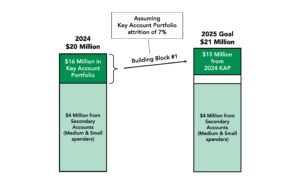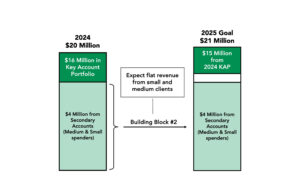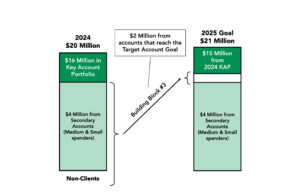At the Creative Resources Group, we have conducted extensive statistical research to understand the factors that lead to the growth of a media company. The data has revealed two metrics that operate as levers that media leaders and managers can use to steer their companies towards growth.
The first lever is the effective management of the Key Account Portfolio (KAP). The attrition of the KAP is the single most accurate predictor of whether a company will grow its revenue year over year. Any media company that wants to make its revenue growth more predictable will need to get the attrition of its Key Accounts under control.
The second most important contributors to growth are the New Key Accounts that are created during the current year. New Key Account revenue must be high enough to mitigate the KAP attrition and attain the company’s top line goal.
As we explain below, it is the way these two groups of large customers are managed that will determine how much a company will grow its revenue.
The Three Building Blocks of Revenue Growth
The image below illustrates a media company that generated $20 Million in 2024 and has set a goal of $21 Million for 2025.

The bar on the left shows that the largest 25% of the active clients in 2024 will be designated as Key Accounts. So, if the company ended the year with 400 active clients, the largest 100 are considered Key Accounts. From experience, we know that those Key Accounts will have generated roughly 80% of the revenue, or $16 million. The remaining $4 million came from small and medium-sized clients, which we call Secondary Accounts.
Building Block No. 1 – Preserving the Key Account Revenue from the Prior Year
Once the Key Accounts have been identified, they need to be managed to preserve as much of the revenue they spent in 2024 as possible. To do that, we have developed a method for organizing them so that Executive Leadership and Sales Management can monitor their total spending as individual accounts and as a group. The instrument we have devised is the Key Account Portfolio (KAP).
All Key Accounts are locked into a KAP for the following year. No accounts can be added or removed, even if they have stopped spending or gone out of business. Starting on January 1, the KAP is managed very much like a mutual fund. Sellers and their managers analyze every Key Account in the portfolio with an eye toward maximizing the accounts with growth potential while minimizing the negative effect of those that shrink or disappear. As each month closes, the company takes stock of the year-to-date attrition experienced by the total KAP.
In the case of our example media company, their KAP had a value of $16 Million at the end of 2024. Now, in 2025, it is the job of the sales organization to preserve as much of that revenue as possible. Indeed, our research shows that if annual KAP attrition exceeds 13% in the aggregate, growth becomes almost impossible to achieve.
Let’s assume that the sales team does a good job of keeping the total KAP attrition to no more than 7%. In that case, they can count on a base of $15 million from their 2024 Key Accounts.
Building Block No. 2 – Revenue from Small and Medium Clients
The second building block contains the $4 million spent by the bottom 75% of active clients in 2024. The data consistently shows that the company will lose as many small and medium-sized clients as it gains over the current year. So, the revenue from that segment of accounts is always projected to stay flat from one year to the next.

Adding the $15 Million from 2024 Key Accounts to the $4 Million from Secondary Accounts gives us $19 Million, which puts us $2 Million away from the company’s $21 Million revenue goal.
Where is that money going to come from? New Key Accounts.
Building Block #3 – New Key Accounts
New Key Accounts are either brand new clients or existing small and medium-sized clients that grow large enough to end up in the top 25% of the list by the end of 2025.
While there will undoubtedly be some accounts that grow into New Key Accounts on their own, media companies need a way to deliberately grow enough New Key Accounts to reach their total revenue goal.
In our experience, only one framework produces enough New Key Accounts every year to create sustained growth. That is a well-organized, aggressive Target Account effort.
The Target Account Effort
The secret to running a successful Target Account effort is to set a minimum level of spending that all Target Accounts are expected to reach. The Target Account Goal is set by adding 30% to the amount spent by the smallest 2024 Key Account.
For example, if the smallest 2024 Key Account spent $40,000, adding 30% to it would result in a $52,000 Target Account Goal for 2025. Simple division tells us that, to make up the company’s remaining $2 Million gap, we need 38 accounts to reach the Target Account Goal.

Adopt a Proactive Strategy to Achieve the Revenue Goals
For media companies to achieve their revenue goals consistently, they need to install systems that will help them reduce the attrition of their Key Account Portfolios and grow the required number of Target Accounts. Executive Leadership and Sales Management must monitor the progress towards achieving those two goals on a monthly basis to keep the sales organization on track to achieve them.


